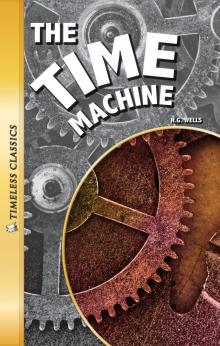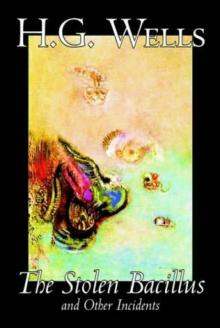- Home
- H. G. Wells
The Time Machine and The Invisible Man Page 2
The Time Machine and The Invisible Man Read online
Page 2
There is nothing unique in this. Think of Gulliver’s Travels (whose long-forgotten original title is Travels into Several Remote Nations of the World), a book that Wells read as a boy and reread throughout his life. In 1726 Jonathan Swift (1667-1745) satirized English political parties, religious quarrels, theories of world government, and science, but his work was so grounded in eighteenth-century British culture that today’s readers need extensive preparation to fathom it. The story of Lemuel Gulliver’s visits to lands populated by giants or intelligent horses has, however, become a staple of children’s literature. The same applies to Robinson Crusoe (1719), by Daniel Defoe (1660-1731). Only scholars see the relationship between Crusoe’s shipwreck and Defoe’s ideas on the fate of the middle classes during the Restoration, when Charles II returned to England in 1660. Defoe’s message and all his political intentions have been lost, but his story endures as a wonderful demonstration of self-reliance. In the literature of the United States, we have the example of Herman Melville (1819-1891) and his Moby Dick (1851): Most readers learn about the ambiguous struggle between good and evil embedded in the work long after they’ve read a novel about nineteenth-century whaling and the strange characters engaged in that dangerous work.
Much the same has taken place with Wells’s Time Machine and The Invisible Man. Wells cloaked his ideas about the future of society and the role of science in the world so well that readers simply do not see those issues and instead read his short novels as examples of a kind of fiction based on the simplest of propositions: “What if it were possible to travel through time by means of a machine?” or “What if it were possible to make oneself invisible?” In a world—one we share with Wells despite the fact that more than a hundred years separates the moment he published these two works from our own age—when scientists seem to make discoveries every day, it requires no great leap of imagination, no “willing suspension of disbelief,” to accept the basic premise of each text.
This is what differentiates Wells from Jules Verne (1828-1905), author of Voyage to the Center of the Earth (1864) and Around the World in Eighty Days (1873). Wells, in a 1934 preface to a collection of his early fictions comments on why they are not comparable to Verne’s writings:
These tales have been compared with the work of Jules Verne and there was a disposition on the part of literary journalists at one time to call me the English Jules Verne. As a matter of fact there is no literary resemblance whatever between the anticipatory inventions of the great Frenchman and these fantasies. His work dealt almost always with actual possibilities of invention and discovery, and he made some remarkable forecasts.... But these stories of mine ... do not pretend to deal with possible things; they are exercises of the imagination in a quite different field. They belong to a class of writing which includes the Golden Ass of Apuleius, the True Histories of Lucian, Peter Schlemil, and the story of Frankenstein.... They are all fantasies; they do not aim to project a serious possibility; they aim indeed only at the same amount of conviction as one gets in a good gripping dream (see, in “For Further Reading,” The Complete Science Fiction Treasury of H.G. Wells, p.i).
Wells links himself to a tradition, but at the same time he misleads the reader. It is true, as he says in the same preface, that “The invention is nothing in itself,” by which he means that the applied science of Verne is of no interest in his kind of tale. It is also the reason why rediscoveries of Verne, especially films, are always set in the past: His projections became fact very quickly. By the same token, this explains why Wells’s inventions and their ramifications will always be modern.
This choice of fantasy over plausible scientific projection is also what separates Wells’s kind of fantasy from writing that depends on magic or the supernatural to shock the reader: There are no werewolves or vampires in these novels, and Wells does not break the laws of nature, except in the instance of the basic proposition animating each fiction—time travel or invisibility. This swerves Wells away from authors of the “Gothic” tradition, like Ann Radcliffe, Matthew Lewis, or Charles Maturin, whose primary intention is to arouse the reader’s fear. That same intention appears in Bram Stoker’s Dracula (1897), published in the same year as The Invisible Man, though, ironically, vampires have come over the years to have their own symbolic values, from being metaphors about sexuality to being symbols of the way capitalists drink the lifeblood of the proletariat.
If we wonder about Wells’s immediate antecedents, we would probably have to begin, following his lead, with Mary Shelley (1797-1851). Frankenstein, or the Modern Prometheus (1818), despite the myriad films based on it, really presents the problems of creation—artistic or scientific—disconnected from traditional notions of morality or religion: creation for the sake of creation or creation for the sake of ego, an idea quite relevant both to the Time Traveller, whose mysterious machine resembles nothing more than a Victorian motorcycle (if such a thing is imaginable) with no visible mechanism, and to the Invisible Man, who labors to make himself invisible only to satisfy his own selfish needs.
The affinities between Mary Shelley’s protagonist, Frankenstein, whose means for infusing life in a pieced-together body Shelley leaves as vague as the time machine in terms of technique, and Griffin, Wells’s invisible protagonist, are clear: Each isolates himself from society to pursue a scientific goal that can only be understood as a triumph of will. Frankenstein has no real altruistic purpose in creating his monster; he only wants to copy God—like the titan Prometheus in Mary Shelley’s subtitle, who fashions man out of clay—by creating a creature who will adore him as its creator. Griffin at first simply wants to see if he can do in fact what he thinks he can do in theory. Only after he becomes invisible does he become a terrorist who threatens the established order of society.
It is that part of Griffin’s story that most concerns Wells, himself unhappy with the status quo and desirous of bringing about changes in society. What Wells hoped would one day come into existence was a socialist state organized along the lines of a factory, but a factory in which labor and management were a single body. He radically opposed the Marxist idea that current society was based on the opposition between an owning class of capitalists and a working class of proletarians. In fact, The Time Machine is a voyage to a future in which the Marxist concept has become fact and society has evolved into two classes of beings: subterraneans who feed and clothe surface dwellers who spend their lives singing, playing, and making love. The horror of this relationship is that the laborers, the apelike Morlocks, use the pretty but brainless Eloi as food.
Wells was certain that Marxist class struggle would produce a working class that was perfectly organized but concerned only with promoting its own interests. Once a kind of harmonious balance was struck between capitalists and proletarians—once the workers got all they wanted and could somehow manage to tolerate the existence of an idle class of owners—both classes would slowly degenerate into subhumans because their intelligence would no longer be challenged.
Wells clearly had Edward Bellamy’s utopian novel Looking Backward (1888) in mind as he wrote and rewrote The Time Machine, which began in 1888 as a series of sketches called The Chronic Argonauts. In his romance, Bellamy (1850-1898) has his hero fall asleep in 1887 and wake up in the year 2000. State ownership has replaced capitalism, and all citizens work for the state. The transformation of society also brings about the transformation of the people, with the result that morality and culture reach new heights. H. G. Wells was simply not convinced that a communism offering a work-free utopia was the best thing for humanity. In fact, his own puritanical work ethic taught him that such a scheme would result in a society of drones living in a mediocre world kept barely functioning by a well-organized but self-interested working class—Marx’s proletariat. Without a spur to force humanity into making new discoveries and expanding its physical or mental frontiers, Wells felt, we would be content with whatever satisfied our basic needs, but nothing more.
The Time Machine, then, st
ands as a pessimistic response to the optimism animating nineteenth-century thought and locates Wells squarely in his historical context. Three thinkers—Hegel, Marx, and Darwin—define the optimistic mind-set of the nineteenth century, itself a logical response to the great strides being made by technology and to the lessons if not the realities of the two great revolutions of the late-eighteenth century, that of the United States in 1776 and the French Revolution of 1789.
Georg Wilhelm Friedrich Hegel (1770—1831) established the predominant concept of how history was thought to be shaped in the nineteenth century. His idea that there is a discernible pattern in history, one in which more and more people enjoy freedom, reflects the European movement away from autocratic, monarchic government to constitutional monarchies in which ordinary citizens are given at least a limited voice in their own governance. Hegel looks back to a past when there is only one free person in society, the autocrat who holds all power, and forward to a time when freedom is shared by many.
How this takes place, Hegel says, is through conflict, the other idea he establishes as a fact of historical thought in the nineteenth century. Hegel’s notion of conflict does not reflect a chaos in which myriad forces strike out at one another but a clash of opposed ideas that crystallize at a certain moment in history, ideas embodied in individuals, parties, and nations. Out of conflict arises a new order, one that combines or synthesizes principles found in both of the opposing forces.
Karl Marx (1818—1883) translated Hegel’s principles into a concrete projection about the future. Observing that technology has acquired a history of its own, that its development is independent of ideology or past history, Marx announced a new era. The nineteenth century, Marx says, is the age of industrialization, in which entrepreneurs and capitalists use industrial technology to organize production for profit. The result of that organization, which, according to Marx, had taken place with astonishing speed, is the creation of a two-class society: those who own the means of production (the capitalist owners of industry) and those who work in their factories (the proletariat). These classes are fundamentally opposed to each other, and their clash will inevitably result in the annihilation of the capitalist class and the triumph of the proletariat, who will seize the means of production and use it for their own benefit. This victory will see the birth of a new world order in which industry and most property will be owned by a state whose only reason for existing will be the well-being of its citizens, a state that will eventually wither away.
Charles Darwin (1809—1882) revolutionized nineteenth-century science with his theory of evolution. Darwin’s idea, that organisms, man included, change over time from one state or condition to another, challenged the theological view that human beings were created by God in His image. Darwin’s principle—that, for example, modern horses began in small animals like eohippus and, over millennia, evolved into equus—declares that evolution is the success of those animals that best meet the challenges of their environment through transmission to successive generations of genetic variations favoring survival—a concept he termed “natural selection.” This theory becomes a lens through which scientists tried to understand the history of the natural world.
It also produced the false corollary “survival of the fittest,” used by those, following Herbert Spencer (1820-1903), who sought to apply Darwin’s ideas to human society—so-called “social darwinists”—to show that there are superior and inferior human types. This perversion of Darwinian thought influenced the views of H. G. Wells on society and shows that he was as much a product of his age as he was a shaper of it. That is, Wells, fascinated by technology and science (his intellectual training was almost totally scientific), gathered into himself the progressive, evolutionary theories that dominated the nineteenth century but transfused them with yet another nineteenth-century idea: entropy.
Loosely stated, entropy describes a tendency in dynamic systems to lose energy and degrade. We might think of a car battery as an example: When new, the battery is able to start the automobile and keep its lights burning. Over time, the chemical reaction that produces the electricity in the battery weakens until finally the battery is dead. Speculative thinkers—notably, in the case of Wells, his teacher, Thomas Henry Huxley (1825-1895)—applied this idea to nature and humanity. Where Darwin’s ideas of human evolution seemed to open a path leading humanity to an almost angelic state, this theory suggests we are susceptible to decay and decline, an idea Wells puts into practice in his first novel, The Time Machine, in which the Time Traveller discovers humanity some eight hundred thousand years in the future to have degenerated into little more than animals.
So in the last third of the nineteenth century, when Wells was beginning his career, thinking people had begun to question the biological, social, and industrial optimism of the century’s first seventy-five years. At the same time, those final decades could not shake themselves free of a dynamic concept of human and natural history—that is, that change may be for the better or it may be for the worse, but the entire universe is subject to change of some kind, in contradistinction to the Judaic or Christian idea of a stable universe created by God (which He will one day destroy).
Humans, Wells thinks, have it within them to take charge of their history but refuse to do so because of ignorance, fear, or self-interest. Why have a monarchy in Great Britain, when no king or queen could hope to govern a modern nation? There is no rational answer to this question since the idea that someone is “naturally” born to lead a people flies in the face of common sense.
Wells would find himself at odds with traditional society over the course of his entire life. He would be a tireless promoter of educational reform: Why study Latin or Greek, he would argue, when British society, especially at the start of the twentieth century, was so desperately in need of people with scientific training? He would eventually envisage a non-Marxist socialism as the best kind of society. He conceived the ideal social system as a single, globalized nation in which all peoples participate, in which all individuals work within industries governed by boards of directors that regulate production and protect the well-being of workers.
Wells wanted to abolish the notion of class conflict by eliminating class distinctions, an idea that certainly put him at odds with British conservatives and with Marxists as well. What current society needed, Wells felt, was a jolt that would startle people into realizing just how haphazard and disorganized their societies were and stimulate them to create a rational and universal society. Such is the thinking behind his 1898 novel The War of the Worlds, in which the invading Martians destroy society and thereby open the way for a new world organization. In real history, Wells hoped that the wholesale destruction of World War I would produce a system of world government so that nation-states would no longer have any reason to be at one another’s throats. It was, he thought, our primitive taste for violence that prevented a better world. In this, as World War II would confirm, he was only too right.
But the H. G. Wells of 1895 was still a young man of twenty-nine struggling to find a way out of poverty and insecurity. He’d recently married for the second time, his first marriage in 1891 to his cousin Isabel Wells having lasted barely two years. Though he and Catherine Robbins (nicknamed Jane) as yet had no children (they would eventually have two sons), Wells was obliged to work nonstop to generate enough income to keep two people alive. As he would say in a 1919 letter to his friend E. S. P Haynes:
Earning a living by writing is a frightful gamble. It depends neither on knowledge nor literary quality but upon secondary considerations of timeliness, mental fashion & so forth almost beyond control. I have been lucky but it took me eight years, while I was teaching & doing anxious journalism, to get established upon a comfortably paying footing (quoted in Norman MacKenzie and Jeanne MacKenzie, H. G. Wells: a Biography, p. 103).
“Anxious journalism” meant writing an article on any subject whatever—from cricket, to swearing, to head colds—and hoping someone would publish i
t.
It was W.E. Henley, an editor Wells had met in 1893, who gave Wells his big chance. Henley was just about to inaugurate a new magazine, The New Review, and offered to publish The Time Machine, whose earlier, cruder version he’d already seen, as a serial. It was Henley who told Wells to stop talking about time travel and instead take his readers on a voyage through time. He also convinced the book publisher William Heinemann to publish the serial as a volume, securing a contract for Wells that gave him a much-needed £50 advance, a first edition of 10,000 copies, and a 15 percent royalty rate. The serial was a wild success, and the novel a bestseller. H. G. Wells overnight found himself transformed from a hack writer one step ahead of starvation and bill collectors into a prominent author.
But success did not tempt Wells into inactivity. In 1896 his most Swift-inspired novel, The Island of Dr. Moreau, appeared, and in 1897 he published his third science fantasy, The Invisible Man. But these major works are merely the tip of the iceberg: Wells also published a comic novel about the bicycling craze in which he enthusiastically participated, The Wheels of Chance (1896), along with two collections of short stories and a slew of miscellaneous articles.
How could this unhealthy man (he suffered from tuberculosis and became seriously ill in 1887 and once again in 1893), totally untrained in “creative writing,” plying the journalist’s trade just to make ends meet, have both the imagination and the will to write—with no typewriter—so many words, compose so many tales? (True enough, he did have help: His second wife made clean copies of his manuscripts.) But the fact is Wells probably wrote much as he had spoken when he addressed his classes as a young teacher. Just as his lectures would have to be pitched to the level of his students, with a vocabulary they could readily fathom and a sentence structure that would elucidate rather than obfuscate the points he wanted to communicate, his fictions are exercises in clarity, and no less didactic than his lectures. In his satiric essay on Henry James (in his 1915 novel Boon), Wells castigated James for his notoriously convoluted style, comparing it to a hippopotamus trying to pick up a pea, and in a letter to James Joyce, whose work he admired but found overly complex, he stated simply, “I want language and statement as simple and clear as possible” (quoted in Michael Foot, The History of Mr. Wells, p. 215). Wells could never espouse the “art-for-art’s -sake” ideal: For him, art—all writing, in fact—had a single purpose, to communicate ideas and provoke change.

 Ann Veronica: A Modern Love Story
Ann Veronica: A Modern Love Story The Time Machine
The Time Machine The First Men in the Moon
The First Men in the Moon The Stolen Bacillus and Other Incidents
The Stolen Bacillus and Other Incidents The War of the Worlds
The War of the Worlds The Invisible Man: A Grotesque Romance
The Invisible Man: A Grotesque Romance The Island of Doctor Moreau
The Island of Doctor Moreau The Door in the Wall, and Other Stories
The Door in the Wall, and Other Stories The Best Science Fiction Stories of H G Wells
The Best Science Fiction Stories of H G Wells The Sea Lady
The Sea Lady The Wonderful Visit
The Wonderful Visit Love and Mr. Lewisham
Love and Mr. Lewisham Marriage
Marriage Tales of Space and Time
Tales of Space and Time The War of the Worlds (Penguin Classics)
The War of the Worlds (Penguin Classics) Twelve Stories and a Dream
Twelve Stories and a Dream The Food of the Gods and How It Came to Earth
The Food of the Gods and How It Came to Earth Tono-Bungay
Tono-Bungay The War in the Air
The War in the Air The Sleeper Awakes
The Sleeper Awakes The Country of the Blind and Other Stories
The Country of the Blind and Other Stories Kipps
Kipps The World Set Free
The World Set Free The Country of the Blind and other Selected Stories
The Country of the Blind and other Selected Stories Ann Veronica
Ann Veronica Ann Veronica a Modern Love Story
Ann Veronica a Modern Love Story The Time Machine and The War of the Worlds
The Time Machine and The War of the Worlds Time Machine and The Invisible Man (Barnes & Noble Classics Series)
Time Machine and The Invisible Man (Barnes & Noble Classics Series) The Time Machine and The Invisible Man
The Time Machine and The Invisible Man The Island of Dr. Moreau
The Island of Dr. Moreau Selected Stories of H. G. Wells
Selected Stories of H. G. Wells Island of Dr. Moreau
Island of Dr. Moreau THE NEW MACHIAVELLI
THE NEW MACHIAVELLI